Greek Art
1/15
There's no tags or description
Looks like no tags are added yet.
Name | Mastery | Learn | Test | Matching | Spaced |
|---|
No study sessions yet.
16 Terms
- grave marker, replacing huge vases of the Geometric period
- general representation of ideal warrior
- rigidly frontal; nude
- arms and legs largely cut free from stone
- freestanding w/ legs appearing to stride forward
- hair knotted and falls in neatly braided rows down the back
- eyes wide open; squarish shoulders
- face masklike
- named after young military hero Kroisos; inscription at base identifies him
- some paint survives
- archaic smile
- strong Egyptian influence but softer features
Anavysos Kouros

- broken hand fitted into socket; probably held an attribute
- may have been goddess
- tightened waist
- breasts revealed beneath drapery
- so=called b/c named for peplos
- rounded and naturalistic face
- much of paint reminds; animates face and hair
- hair falls naturally beside body
Peplos Kore from the Acropolis
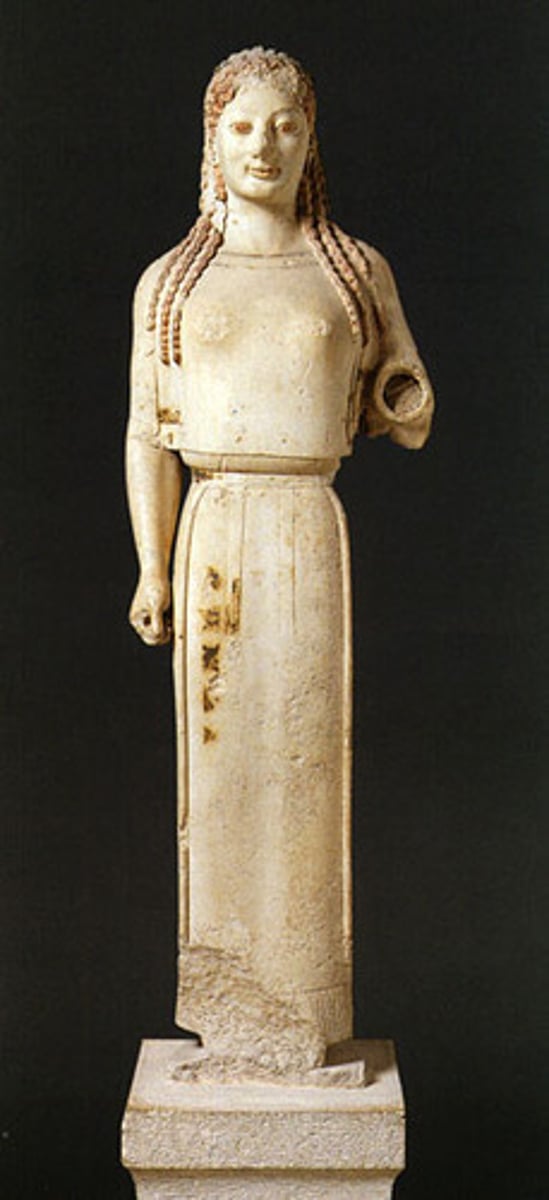
- contrapposto
- blocklike solidity
- broad shoulders, thick torso, muscular body
- warrior and athlete
- hand once held a pear
- averts gaze; may admire him, but he does not recognize it
- found in Pompeii in a place for athletic training
- also referred to as The Canon
- tense and relaxed limbs oppose each other diagonally
Doryphorus (Spear Bearer)
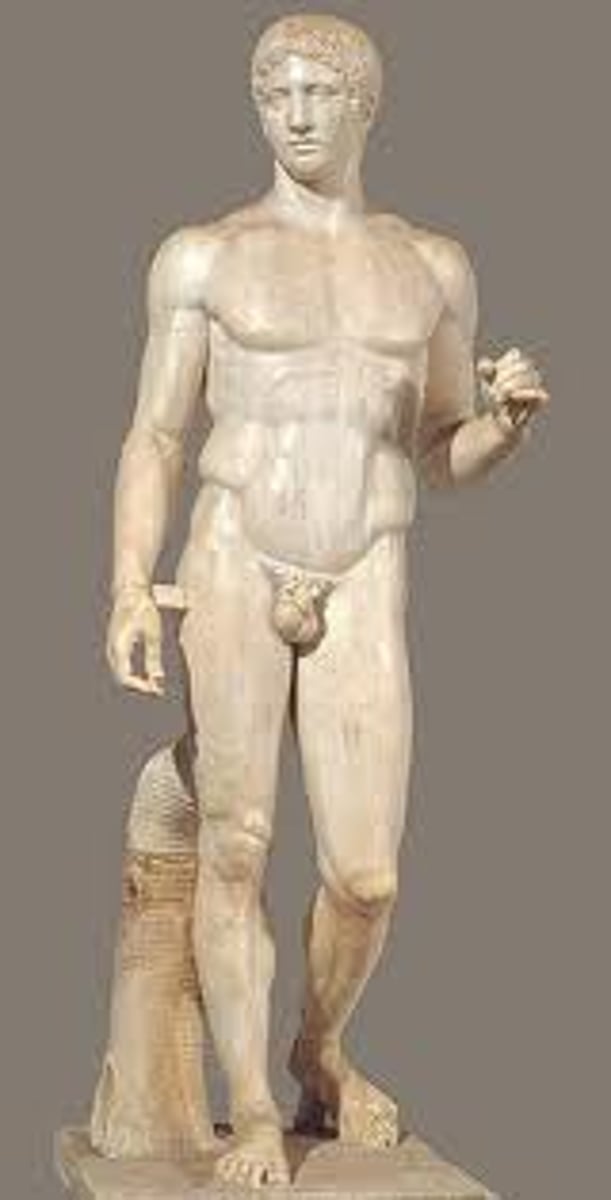
- Parthenon sculptures, also called the Elgin Marbles
- east pediment of the Parthenon
- shows birth of Athena from the head of Zeus; other deities watching
- two seated figures goddesses Demeter and Persephone
- sculptures comfortably sit in triangular space of pediment
- classical art; contrapposto
Helios, Horses and Dionysos
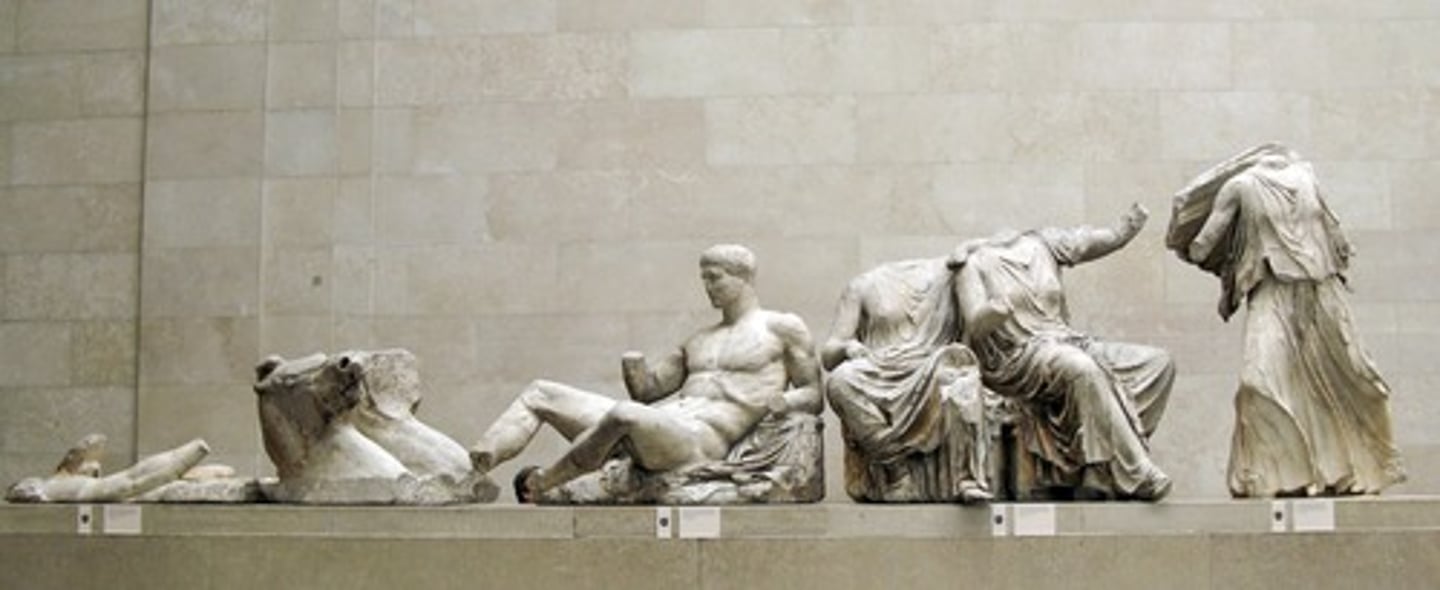
- scene from the Panathenaic Frieze depicting the Panathenaic Procession, held every four years to honor Athena
- first time in Greek art showing depiction of human event on temple
- higher up relief placement, more 3D relief was cared (in order to be seen better from below)
- procession began at Dipylon Gate, passed through agora, ended at Parthenon
- Athenians placed new peplos on statue of Athena
- Six Ergastines (young women in charge of weaving Athena's peplos) greeted by two priests
- Isocephalism
- new theory: not Panathenaic Procession, but story of legendary Athenian king, Erechtheus, who sacrificed on of his daughters to save city of Athens; told to do so by Oracle of Delphi
- elevated Athenian citizens almost to stature of gods
Plaque of the Ergastines
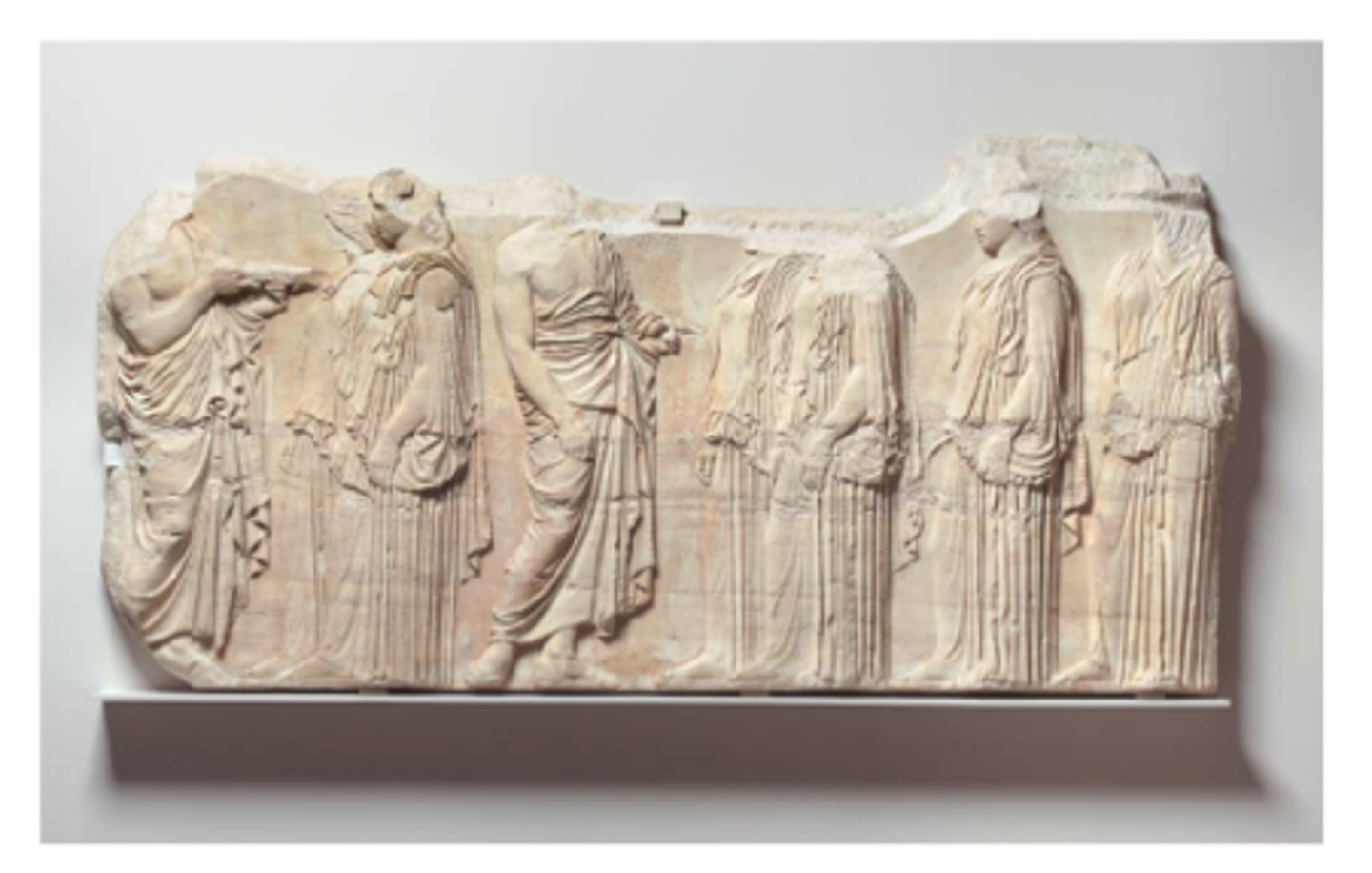
- graceful winged figure modeled in high relief
- deeply incised drapery lines reveal body, wet drapery
- awkward ungainly pose --> graceful dance step
- representative of sculptors looking for unexplored ways to use human figure as expressive medium
Victory Adjusting Her Sandal
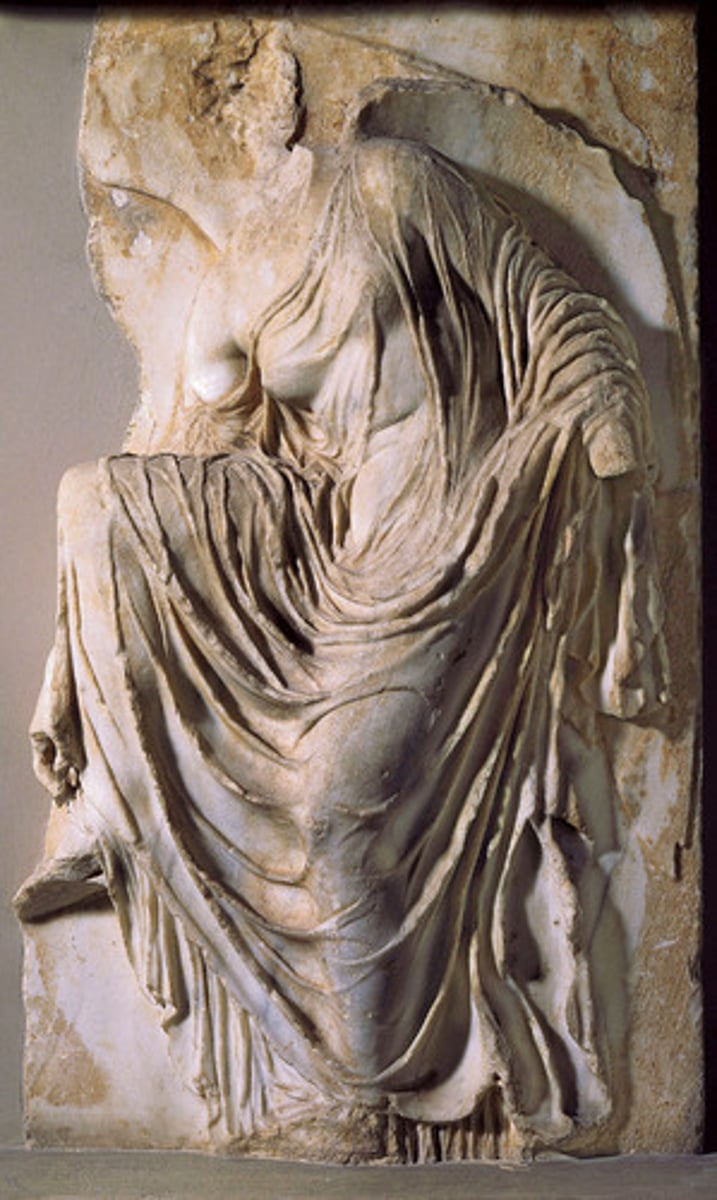
- classical work
- erected in Dipylon cemetery in Athens
- commemorates death of Hegeso; inscription identifies her and her father
- genre scene: woman examining piece of jewelry from jewelry box handed to her by standing servant; may represent her dowry
- jewelry painted in, not visible
- Hegeso's status shown in her foot being on base of chair, not ground
Grave Stele of Hegeso
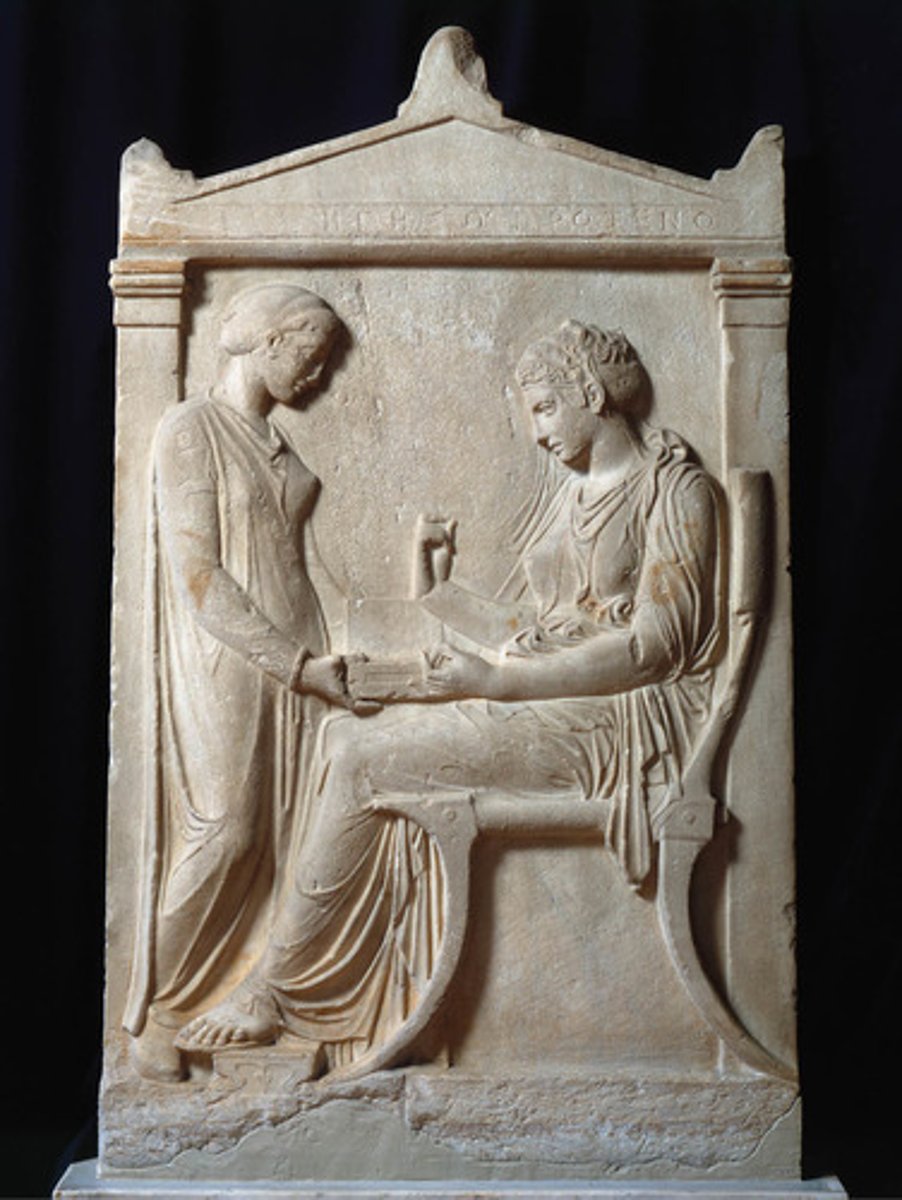
- meant to stand in/above fountain cascading water around rocks below OR adorn bow of a stone ship
- wet drapery look imitates water on wet body
- evidence of invisible wind on body
- dramatic twist and contrapposto of torso
- monumentality of figure
- missing right arm may have raised victory crown or held open hand in greeting
- boat at base battleship w/ oarboxes and traces of a ram
- probably built to commemorate navel victory in 190 BCE
- goddess of victory; job to spread message of victory
- found in 1863 in situ on Samothrace
Winged Victory of Samothrace
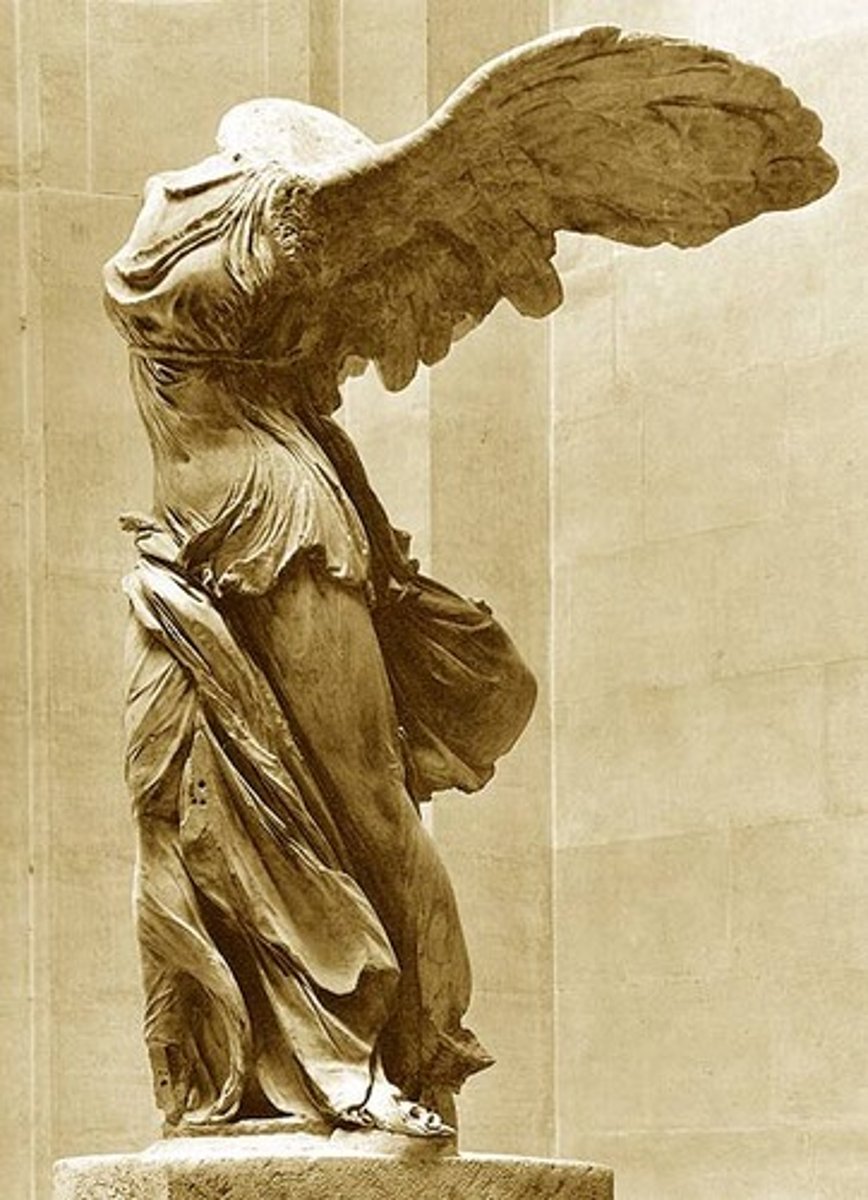
- gigantomachy; giants (as helpless tools) dragged up the stairs to worship the gods
- gods' victory over giants parallels Alexander the Great's defeat of the Persians
- deeply carved figures overlap one another; masterful handling of spatial illusion
- dramatic intensity of figures, movement; heroic musculature
- Athena grabs Alkyneos by hair and drags him up stair to worship Zeus
- Nike on right crowns Athena in victory
- Gaia (earth goddess) looks on in horror and pleads for the fate of the giants (her sons)
- figures dominate space
Athena (from Pergamon)

- may have been part of a group; maybe single sculpture w/ head turned to face unseen opponent
- older man, pas his prim
- mostly defeated look
- smashed nose; lips sunken in to suggest broken teeth
- cauliflower ears (happens when ear injury is ignored; cartilage allowed to overgrow)
- nude fighter; hands wrapped in leather bands
- blood denoted in copper dripping from face and onto right arm and thigh
- copper highlights on lips, nipples, straps on leather gloves, wounds on head
- may have been good luck charm for athletes; evidence of toes worn away by touching
- thoughtful gaze, hunched shoulders, defeated posture
Seated Boxer
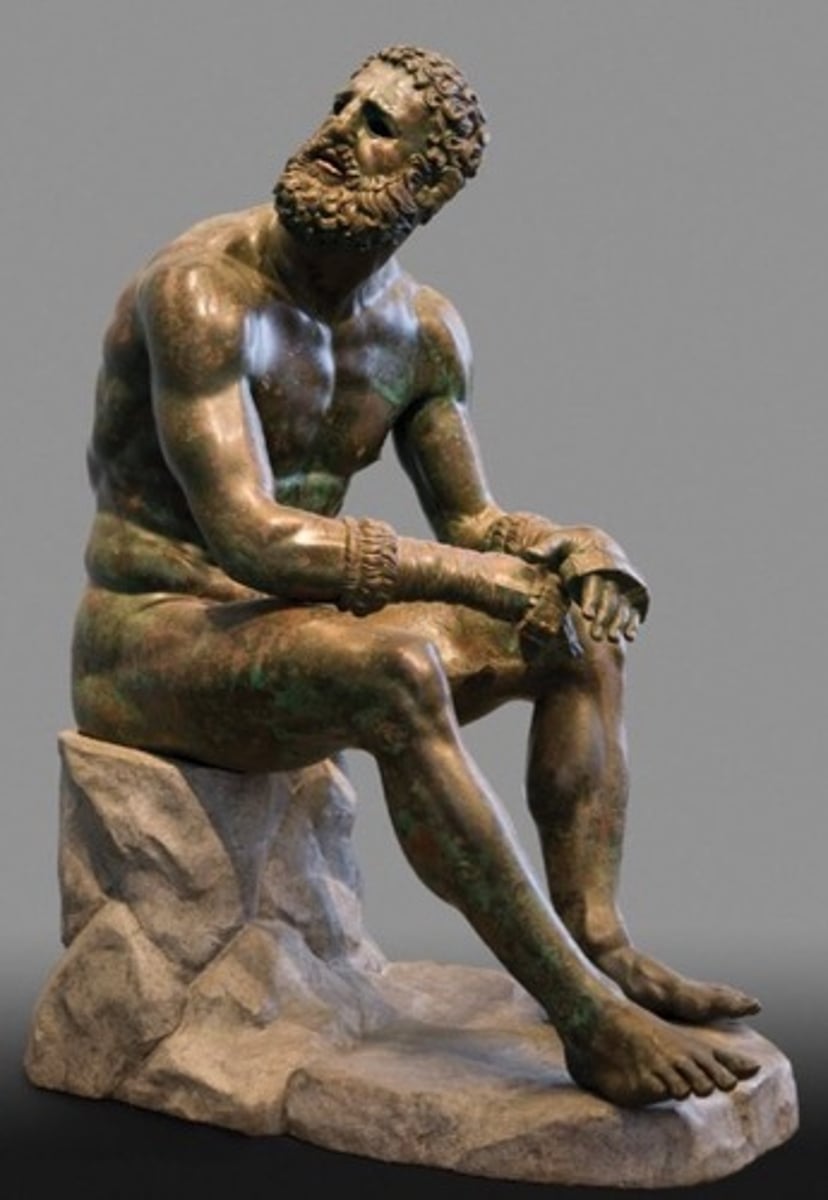
- grew out of demand of needs by inhabitants, as opposed to Hippodamian Plan
- became seat of ruling body of Athens
- plaza at base of Acropolis in Athens; contained commercial, civic, religious, social buildings; ceremonies took place here
- setting for Panathenaic Festival; Panathenaic Way cuts through plaza from northwest to southeast corners
- plaza surrounded by important buildings, including bouleuterion, tholos, stoas
Athenian Agora

- constructed under leadership of Pericles (after Persian sack of Athens in 480 BCE that destroyed original Acropolis)
- funded by extra funds in Persian war treasury; Greek allies furious
- used algebra and geometry
- unusually light interior w/ two windows in cella
- floor curves upward in center of facade; drain off rain water; deflect appearance of sagging at ends
- columns at ends surrounded by light; made thicker to look same as other columns
- Ionic elements in Doric temple: rear room w/ Ionic capitals; frieze on interior Ionic
- house massive statue of Athena; made of gold and ivory over wooden core
- dedicated to and under protection of Athena
- "architectural contrapposto"
The Parthenon
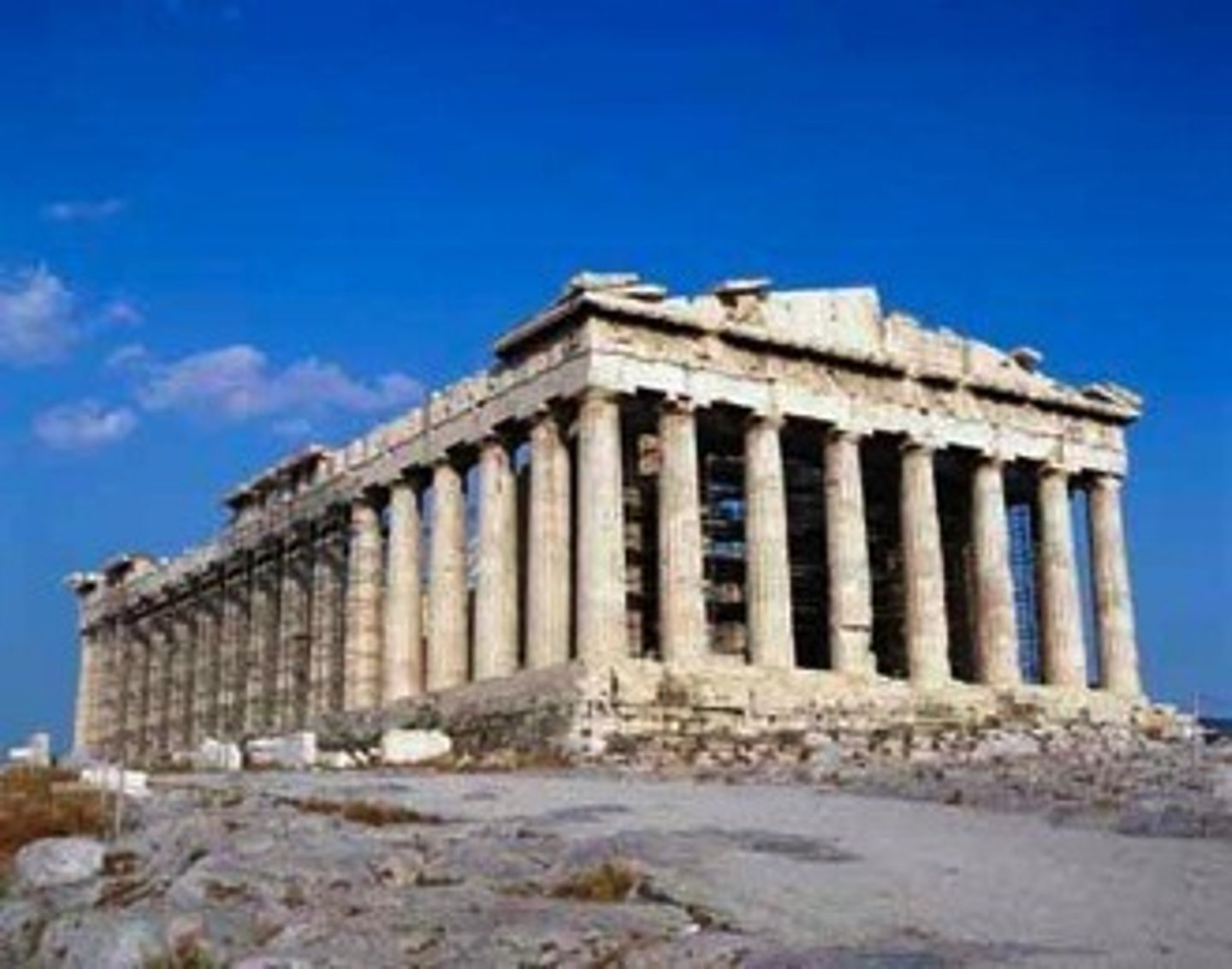
- Amphiprostyle plan
- commemorate Greek victory over Persians in Battle of Marathon
- many images on victory on temple
- cella faces inward toward Acropolis
Temple of Athena Nike

- altar placed on elevated platform up dramatic flight of stairs
- conscious effort to be in dialogue with Panathenaic Frieze on Parthenon
- 7 1/2 foot high frieze over 400 feet long wraps around monument
- contains altar dedicated to Zeus
- Ionic columns frame
- battle unfolds as viewers ascend stairs
- parallels between King Attalos I's victories over Gauls in recent war, Alexander the Great's defeat of Perisans, and gods' defeat over giants in mythology
Altar of Zeus and Athena at Pergamon
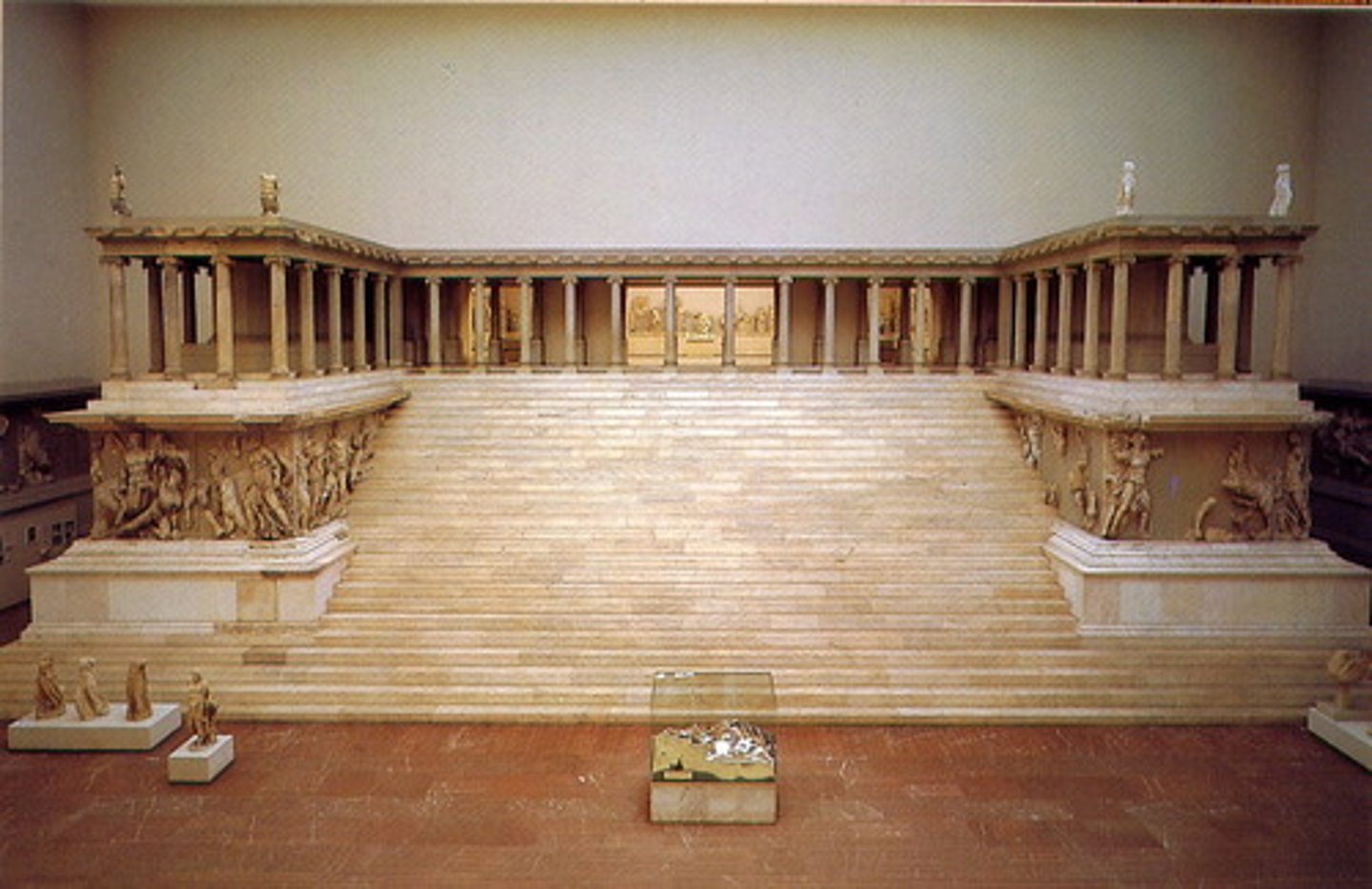
- found in Orvieto, Italy
- one side depiction of the killing of Niobid's children: Niobid bragged about her fertility to god Leto, who only had two children; his two children (Apollo and Artemis) seek revenge by killing Niobid's 12; Niobid punished for her hubris
- other side debated; theories: Hercules surrounded by heroes in arms and Athena; warriors of Marathon place themselves under protection of Hercules
- first time in vase painting isocephalism not used; may have been under influence of wall paintings
Niobides Krater
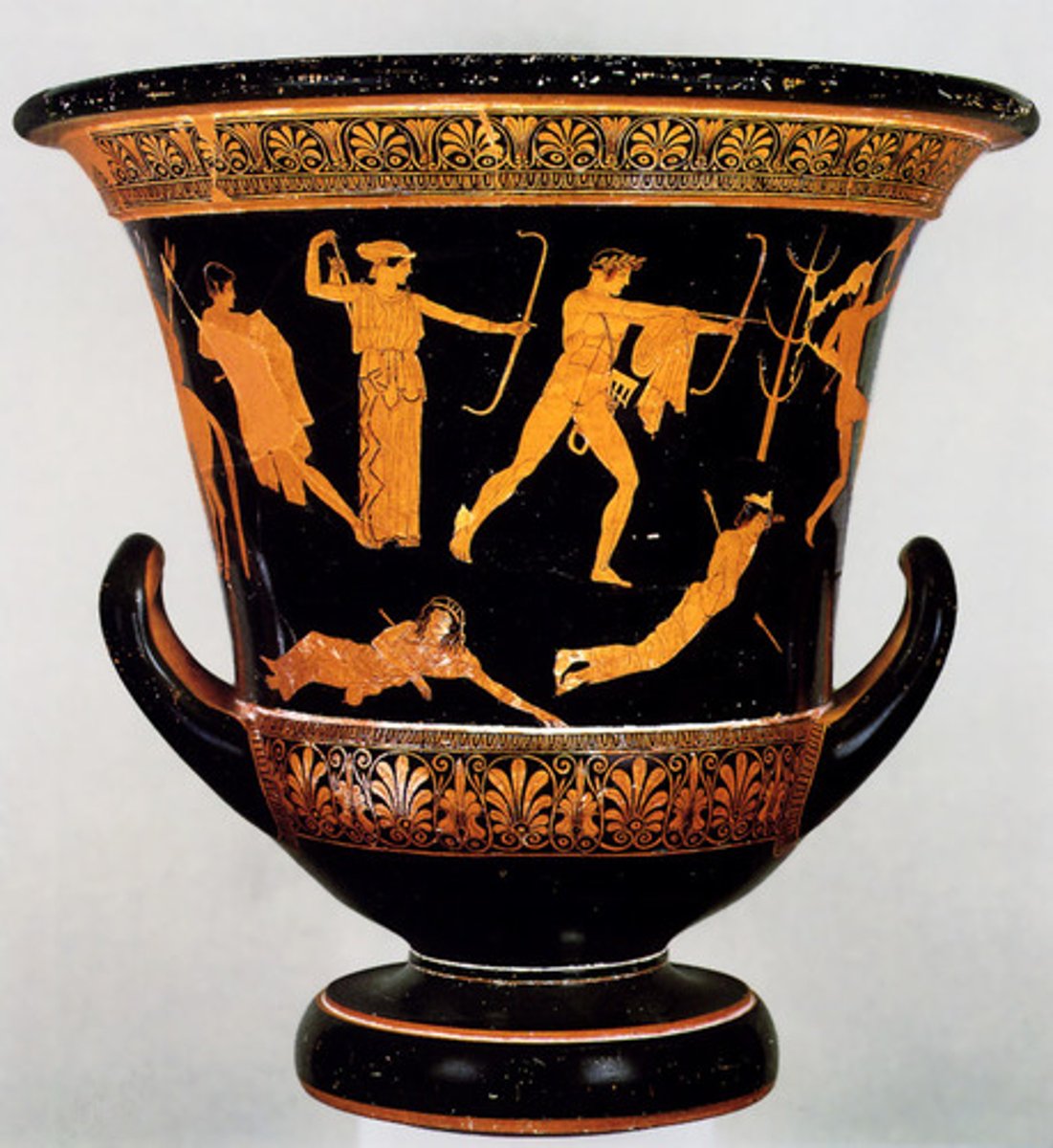
- Alexander at left: young, brave, forthright, assured of success
- Darius in center right on chariot: horrified, weakly ceding victory; charioteer commands horses to make their escape
- crowed, w/ nervous excitement
- Roman floor mosaic based on original Greek mural (?) painting made by [Philoxenos of Eretria for King Cassander] OR [Helen of Egypt (one of few female Greek artists we know of)]
- found at Pompeii
- extremely complex interweaving of figures
- depicts Battle of Issus: Alexander defeats King Darius III of Perisa
Alexander Mosaic (from the House of Faun)
